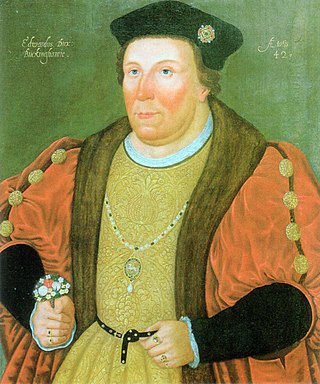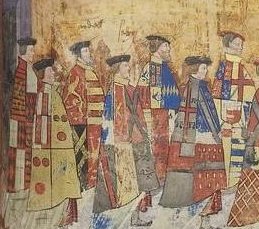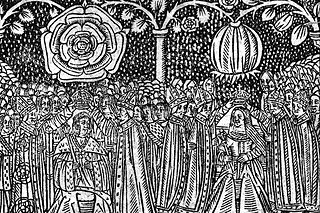
Catherine of Aragon was Queen of England as the first wife of King Henry VIII from their marriage on 11 June 1509 until their annulment on 23 May 1533. Born in Spain, she was Princess of Wales while married to Henry's elder brother, Arthur, Prince of Wales, for a short period before his death.

Thomas Wolsey was an English statesman and Catholic bishop. When Henry VIII became King of England in 1509, Wolsey became the king's almoner. Wolsey's affairs prospered and by 1514 he had become the controlling figure in virtually all matters of state. He also held important ecclesiastical appointments. These included the Archbishop of York—the second most important role in the English church—and that of papal legate. His appointment as a cardinal by Pope Leo X in 1515 gave him precedence over all other English clergy.

Mary Tudor was an English princess who was briefly Queen of France as the third wife of King Louis XII. Louis was more than 30 years her senior. Mary was the fifth child of Henry VII of England and Elizabeth of York, and the youngest to survive infancy.

Arthur, Prince of Wales, was the eldest son of King Henry VII of England and Elizabeth of York, and an older brother to the future King Henry VIII. He was Duke of Cornwall from birth, and he was created Prince of Wales and Earl of Chester in 1489. As the heir apparent of his father, Arthur was viewed by contemporaries as the great hope of the newly established House of Tudor. His mother, Elizabeth, was the daughter of the Yorkist king, Edward IV, and his birth cemented the union between the House of Lancaster and the House of York.

Jousting is a medieval and renaissance martial game or hastilude between two combatants either on horse or on foot. The joust became an iconic characteristic of the knight in Romantic medievalism.

Edward Stafford, 3rd Duke of Buckingham was an English nobleman. He was the son of Henry Stafford, 2nd Duke of Buckingham, and Katherine Woodville, and nephew of Elizabeth Woodville and King Edward IV. Thus, Edward Stafford was a first cousin once removed of King Henry VIII. He frequently attended the courts of Henry VII and Henry VIII. He was convicted of treason and executed on 17 May 1521.

The Tudor rose is the traditional floral heraldic emblem of England and takes its name and origins from the House of Tudor, which united the House of Lancaster and the House of York. The Tudor rose consists of five white inner petals, representing the House of York, and five red outer petals to represent the House of Lancaster.

Henry, Duke of Cornwall was the first living child of King Henry VIII of England and his first wife, Catherine of Aragon, and though his birth was celebrated as that of the heir apparent, he died within weeks. His death and the failure of Henry VIII and Catherine to produce another surviving male heir led to succession and marriage crises that affected the relationship between the English church and Roman Catholicism, giving rise to the English Reformation.

Henry Courtenay, 1st Marquess of Exeter, 2nd Earl of Devon, KG, PC, feudal baron of Okehampton, feudal baron of Plympton, of Tiverton Castle, Okehampton Castle and Colcombe Castle all in Devon, was a grandson of King Edward IV, nephew of the queen consort, Elizabeth of York and a first cousin of King Henry VIII. Henry Courtenay was a close friend of Henry VIII, having "been brought up of a child with his grace in his chamber".

Sir Thomas Wriothesley was a long serving officer of arms at the College of Arms in London. He was the son of Garter King of Arms, John Writhe, and he succeeded his father in this office.

The ceremonies and festivities accompanying a formal entry by a ruler or his/her representative into a city in the Middle Ages and Early Modern Period in Europe were known as the Royal Entry, Triumphal Entry, or Joyous Entry. The entry centred on a procession carrying the entering ruler into the city, where they were greeted and paid appropriate homage by the civic authorities, followed by a feast and other celebrations.

The Accession Day tilts were a series of elaborate festivities held annually at the court of Elizabeth I of England to celebrate her Accession Day, 17 November, also known as Queen's Day. The tilts combined theatrical elements with jousting, in which Elizabeth's courtiers competed to outdo each other in allegorical armour and costume, poetry, and pageantry to exalt the queen and her realm of England.

Greenwich armour is the plate armour in a distinctively English style produced by the Royal Almain Armoury founded by Henry VIII in 1511 in Greenwich near London, which continued until the English Civil War. The armoury was formed by imported master armourers hired by Henry VIII, initially including some from Italy and Flanders, as well as the Germans who dominated during most of the 16th century. The most notable head armourer of the Greenwich workshop was Jacob Halder, who was master workman of the armoury from 1576 to 1607. This was the peak period of the armoury's production and it coincided with the elaborately gilded and sometimes coloured decorated styles of late Tudor England.

John Blanke was a musician of African descent in London from the early Tudor period, who probably came to England as one of the African attendants of Catherine of Aragon in 1501. He is one of the earliest recorded black people in what is now the United Kingdom after the Roman period. His name may refer to his skin colour, derived either from the word "black" or possibly from the French word "blanc", meaning white.

The Westminster Tournament Challenge was the invitation to the 1511 Westminster Tournament, the joust held in honour of the birth a son Prince Henry to Catherine of Aragon and Henry VIII on New Year's Day 1511. Written in the form of an allegory, The Challenge begins by introducing the four challengers who have come from the realm of Cuere Noble to ‘accomplish certain feates of Armes.’ in honour of the ‘byrthe of a yong prynce'. Each challenger is given an allegorical name: Sir William Courtenay as Bone voloyr, Sir Edward Neville as Joyous panser, Sir Thomas Knyvet as Vailliaunt desyre, and Henry VIII as Cuere loyall. This is followed by a description of the tournament's allegorical theme along with the rules and regulations to which the challengers and answerers will adhere. It concludes with the signatures of those who took part over the two days of the joust

The coronation of Elizabeth I as Queen of England and Ireland took place at Westminster Abbey, London, on 15 January 1559. Elizabeth I had ascended the throne at the age of 25 upon the death of her half-sister, Mary I, on 17 November 1558. Mary had reversed the Protestant Reformation which had been started by her two predecessors, so this was the last coronation in Great Britain to be conducted under the authority of the Catholic Church. Historians view Elizabeth's coronation as a statement of her intention to restore England to Protestantism, but to allow the continuation of some Catholic customs, a compromise known as the Elizabethan Settlement.

Ellen or Elen More was an African servant at the Scottish royal court. She probably arrived in Scotland in the company of a Portuguese man with imported animals. There are records of clothing and gifts given to her, although her roles and status are unclear. Some recent scholarship suggests she was enslaved, and her arrival in Scotland can be linked indirectly with the slave trade. She is associated with a racist poem by William Dunbar, and may have performed in Edinburgh as the "Black Lady" at royal tournaments in 1507 and 1508.

The coronation of Anne Boleyn as Queen of England took place at Westminster Abbey, London, England, on 1 June 1533. The new queen was King Henry VIII's second wife, following the annulment of his first marriage to Catherine of Aragon.

The coronation of Henry VIII and his wife Catherine as King and Queen of England took place at Westminster Abbey, London, on 24 June 1509. Henry ascended the throne two months prior, following the death of King Henry VII on 21 April, and Catherine became his wife and queen on 11 June. The ceremony was presided over by William Warham, the incumbent Archbishop of Canterbury, and organized by Lady Margaret Beaufort, the King's grandmother.

The coronation of Edward VI as King of England and Ireland took place at Westminster Abbey, London, on 20 February 1547. Edward ascended the throne following the death of King Henry VIII.




















